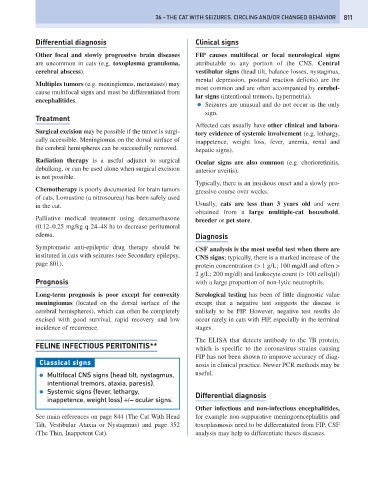Page 819 - Problem-Based Feline Medicine
P. 819
36 – THE CAT WITH SEIZURES, CIRCLING AND/OR CHANGED BEHAVIOR 811
Differential diagnosis Clinical signs
Other focal and slowly progressive brain diseases FIP causes multifocal or focal neurological signs
are uncommon in cats (e.g. toxoplasma granuloma, attributable to any portion of the CNS. Central
cerebral abscess). vestibular signs (head tilt, balance losses, nystagmus,
mental depression, postural reaction deficits) are the
Multiples tumors (e.g. meningiomas, metastases) may
most common and are often accompanied by cerebel-
cause multifocal signs and must be differentiated from
lar signs (intentional tremors, hypermetria).
encephalitides.
● Seizures are unusual and do not occur as the only
sign.
Treatment
Affected cats usually have other clinical and labora-
Surgical excision may be possible if the tumor is surgi- tory evidence of systemic involvement (e.g. lethargy,
cally accessible. Meningiomas on the dorsal surface of inappetence, weight loss, fever, anemia, renal and
the cerebral hemispheres can be successfully removed. hepatic signs).
Radiation therapy is a useful adjunct to surgical Ocular signs are also common (e.g. chorioretinitis,
debulking, or can be used alone when surgical excision anterior uveitis).
is not possible.
Typically, there is an insidious onset and a slowly pro-
Chemotherapy is poorly documented for brain tumors gressive course over weeks.
of cats. Lomustine (a nitrosourea) has been safely used
in the cat. Usually, cats are less than 3 years old and were
obtained from a large multiple-cat household,
Palliative medical treatment using dexamethasone breeder or pet store.
(0.12–0.25 mg/kg q 24–48 h) to decrease peritumoral
edema. Diagnosis
Symptomatic anti-epileptic drug therapy should be CSF analysis is the most useful test when there are
instituted in cats with seizures (see Secondary epilepsy, CNS signs; typically, there is a marked increase of the
page 801). protein concentration (> 1 g/L; 100 mg/dl and often >
2 g/L; 200 mg/dl) and leukocyte count (> 100 cells/μl)
Prognosis with a large proportion of non-lytic neutrophils.
Long-term prognosis is poor except for convexity Serological testing has been of little diagnostic value
meningiomas (located on the dorsal surface of the except that a negative test suggests the disease is
cerebral hemispheres), which can often be completely unlikely to be FIP. However, negative test results do
excised with good survival, rapid recovery and low occur rarely in cats with FIP, especially in the terminal
incidence of recurrence. stages.
The ELISA that detects antibody to the 7B protein,
FELINE INFECTIOUS PERITONITIS** which is specific to the coronavirus strains causing
FIP has not been shown to improve accuracy of diag-
Classical signs nosis in clinical practice. Newer PCR methods may be
● Multifocal CNS signs (head tilt, nystagmus, useful.
intentional tremors, ataxia, paresis).
● Systemic signs (fever, lethargy,
Differential diagnosis
inappetence, weight loss) +/- ocular signs.
Other infectious and non-infectious encephalitides,
See main references on page 844 (The Cat With Head for example non-suppurative meningoencephalitis and
Tilt, Vestibular Ataxia or Nystagmus) and page 352 toxoplasmosis need to be differentiated from FIP. CSF
(The Thin, Inappetent Cat). analysis may help to differentiate theses diseases.

